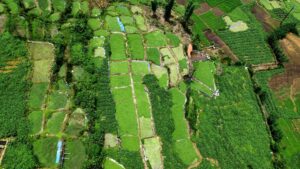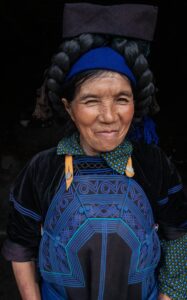By: Nicoletta Baeva
With over 50 ethnic groups residing within its territory, Vietnam is a country of great cultural and linguistic diversity. Ethnic minorities in Vietnam are mostly hill tribes inhabiting mountainous regions with high altitudes. Particularly, the Sapa area, located in the province of Lao Cai, in the northwestern part of the country (close to the border with China), is a centre of Vietnamese tribal culture. If you’re planning a trip to Asia, Vietnam is a top destination worth considering for its rich culture, natural beauty, and affordable travel experiences.

The Untold History of Sapa’s Ethnic Tribes
There are four main ethnic groups residing in Sapa:
- The Hmong (52%)
- Red Dao (25%)
- Tay (5%)
- and Giay (2%)
Besides that, residents include minor percentages of the Muong tribe, the Tay tribe, the Hoa tribe, and the Xa Pho. Interestingly enough, besides its own unique culture and historical background, each hill tribe in Sapa has its own distinctive language. This was confirmed by a friend of mine who, during her visit to Sapa to gather information for her thesis research, shared that even as a native Vietnamese speaker, she couldn’t understand the locals. The Tay could speak Thai well, the Hmong and Muong could speak Cambodian well, and many could speak Chinese (Javier B., 9th Dec 2020, personal communication).

How Sapa’s Hill Tribes Found Their Home in the Mountains
It is believed that the hill tribes originally settled in the Sapa region because the Kinh people, Vietnam’s ethnic majority from the lowland areas, never extended their settlements into the higher mountainous zones.
The Untold History of Sapa’s Ethnic Tribes
H’MONG tribe: The H’mong people came to Vietnam 300 years ago from China. Unfortunately, due to their literacy being low, there isn’t much written history of Hmong people in Vietnam. Therefore, Hmong traditions and stories are passed down through rituals and legends. Vietnam’s Hmong society is patriarchal, meaning that each Hmong village has a chief head who takes care of all issues that arise.

Tay tribe: Having come to Sapa about 500 BC, the Tay people are the largest ethnic minority in Vietnam making 2% of the Vietnamese population and according to worldtravelconnector.com they are the most integrated ethnic minority in modern Vietnamese and Kinh culture. Astrology is an important part of their belief system. So much so, that they consult astrology when it comes to marriages and constructing new houses.
Red Dao tribe: This tribe is the second-largest ethnic minority in Sapa district and one of the most distinctive Vietnam tribes. They are also called ‘Jungle People‘. Their unique belief system includes elements of Confucianism, Buddhism and Taoism. When choosing a place for a house, they dig a hole and fill it with rice. The rice represents family members and all their possessions. Another interesting fact about the red Dao is their distinctive clothing: a distinctive red triangular-shaped turban, decorated with silver coins and red tassels. The square piece on their clothing is meant to symbolise that they are children of God.
Giay tribe: Their customs are influenced by Chinese culture. However, they also speak the Thai language. The Giay people are well known for their five-colored steamed sticky rice symbolizing the five elements of Nature: earth, water, fire, wood, and metal.
Best time to visit Sapa
Nowadays, Sapa welcomes a wide range of visitors, attracted by the hill tribes, scenic rice paddies and mesmerising forests. The best time to visit Sapa is in September and October when the rice terraces are at their most splendid; or in April and May when the weather is ideal, and skies are clear.
Thing to do in Sapa
Listen to folk music: According to responsibletravel.com, one can listen to folk music in local homes, witness traditional Tay and Dao dance, stroll around village markets and help local families with gardening and taking care of domestic animals.
Go trekking: Sapa offers some of Vietnam’s best trekking, and some villages, such as Cat Cat and Ta Phin, can be seen without a guide. Book an overnight trek to wander through rice terraces, bathe in waterfalls and experience ethnic culture firsthand.
Visit local market: Every Sunday the Bac Ha market bursts into life, as hundreds of traders from the Dzao, Han, Xa Fang, Tay and Thai tribes descend on the market, decked out in traditional garb. Expect a riot of colour and excited haggling.
Staying in Sapa: From Budget Hotels to Meaningful Homestays
Considering its small size, there are quite some accommodation options in Sapa. The majority of accommodation caters to locals and backpackers. Hotel prices in Sapa are considerably cheaper as compared to large cities, thus a comfortable guest house should be within the budget of most visitors.

Sapa is also a great place to opt for a homestay, as there are many options to do so. This type of accommodation is perfect for experiencing the local way of life. The hosts are usually curious to learn about you and share their stories over a delicious home cooked meal. Nowadays, there are many Tour Operators that offer all inclusive homestays in Sapa. One thing to consider is that Tour agencies have been known to take excessive profits from the local people. Booking through an NGO might be a better option. There are quite some NGOs in Sapa, offering treks and homestays that support the community.
Community-Based Tourism in Sapa
Organisations like Sapa Sisters, Ethos – Spirit of Community and Sapa O’Chau offer experiences that provide fair salary and opportunities to locals. They also work on other community development initiatives in the region; therefore your money goes directly to the local people.

Very interessing & serious work
[…] region is home to various ethnic groups that, in addition to rice farming, have also preserved their traditional crafts. A tour to […]